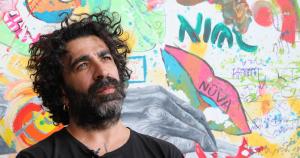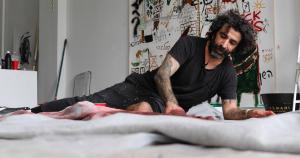Award-Winning Conceptual Artist Tomer Peretz Promotes Healing and Awareness Through Unconventional, Bold Art Forms
Peretz has been heralded an icon of experiential art and continues to stun communities around the world with unexpected art displays––oftentimes enlisting volunteers for peaceful and coordinated live flash mobs, setting up staged gory scenes in public setting to evoke education and action to atrocities around the world, inviting victims of trauma to powerfully express in art what words cannot, and so much more. From the gallery to the world stage, Peretz utilizes the world as his blank canvas for some of the most jaw-dropping artistry3 the world has seen.
“My style has always been underground and loved it. I don’t like the mainstream.... I’m dark, but there is a lot of hope in my work and just want people to feel through my art. I’m not a ‘typical artist’ kind of a guy. I don’t think about aesthetics too much, I care more about the subject-matter and the story.” – Peretz
Peretz offers a stunning glimpse of his unconventional artistry, backstory, and what’s next for the acclaimed artist.
Q: How did you first discover art as your passion? Was it always an outlet for emotion or a hobby that developed into a profession?
A: Around the age of 14, I was aware of my passion. It was just a getaway for me at that time. I was drawing every day for hours, always drawing people’s emotions.
Q: What are some of the common themes, styles, and emotions that your artwork conveys?
A: Traumas, sadness, darkness, realness, real stories, sarcasm, politically incorrect, faith, redemption––the things that no one wants to talk about. I do enjoy the mix between realism and surrealism.
Q: What are some forms of art that you commonly create?
A: Live art installations made from people, large scale paintings, art installations made from useable material, and replicas of different elements in different sizes.
Q: How does artwork evoke awareness, education, and healing?
A: Art is a visual language that speaks to all people in different ways. Art is also a subconscious language. Sometimes it’s easier to speak art than speak words.
Q: What feedback have you received from your artwork? How do people respond to your live art flash mobs and other bold live art demonstrations?
A: There is no one kind of a response. It's always extreme and different. I create things that are hard to talk about. I create emotions, and sometimes it’s negative and that’s ok, it’s all part of it.
Q:What are some recent live art demonstrations that have received the most buzz and interest?
A: “When the Music Stopped” project included over 1,000 people who were part of it. We created a massacre demonstration. I wanted to show what 1,000 dead people look and feel like.
Q: What is art therapy and how do you offer that for victims of trauma through the Peretz Foundation? How is it healing? What have you recently created/shared to those affected by the 10/7 massacre?
A: Art therapy is a mental health profession that helps individuals to heal different traumas, through art creation. I'm not a professional therapist, I'm just an artist, but I have very good communication skills with those individuals because of my experience at this war and previews wars. I'm guided by professional therapists from the organization NATAL that supports my activism. So far, I've seen great success with the groups I’ve been working with.
Q: What is your personal connection to the 10/7 tragedy and how is your artwork offering hope, help, healing, and awareness through art?
A: After volunteering with Zaka on 10/7, and clearing dozens of dead bodies, I had been exposed to the most horrific things you can ever imagine. I also realized art was simply helping me to help me to get out of bed and come out of depression. I now offer the same for others who are suffering, as it helped me.
Q; What's next for you? Where can people see/find your artwork and engage with your art therapy, Peretz Foundation?
A: The next thing for me is working with many groups with different traumas. I’m working on a huge exhibition in Israel to tell stories and travel with them to show it around the world––showing the soul of people who changed our lives forever.
Q: Current and/or upcoming announcements, projects in development, conferences, press conferences, and/or events.
A: From March 28th through April 16th, I’ll be working at Niros Gallery studio in Tel Aviv, Israel, with hostages, their families, injured soldiers, soldiers with post-traumatic stress disorders, politicians, other artists, bereaved kids and seniors, and more. I also credit Michael Mike Cannon who is an exceptional videographer and photographer who’s been with me 24/7.
Q; Where can people find some of your acclaimed collections?
A: Some of my art can be found in galleries throughout Los Angeles, Las Vegas, Israel, Mexico, and throughout Europe, and is currently available in Fabbrica Eos Milano (Milan, Italy) and Maragoni Institute Miami (Miami, Florida).
WEBSITE AND LINKS
Website: https://tomerperetz.com/
Video: https://youtu.be/gz9PlZxKTkQ?si=7yCaOZ6SwSCU8hEZ
Instagram: https://www.instagram.com/tomerperetzart/
Facebook: https://www.facebook.com/Tomerperetzart
Ruth Davis
Ruth Davis Consulting LLC (RDC)
RuthDavisConsultingLLC@gmail.com
Visit us on social media:
Facebook
Twitter
LinkedIn
Instagram
Other
WATCH NOW: When the music Stopped, Miami. By Tomer Peretz and team. at http://www.youtube.com/watch?v=gz9PlZxKTkQ

1 https://tomerperetz.com/
2 https://www.instagram.com/tomerperetzart/
3 https://www.facebook.com/Tomerperetzart



